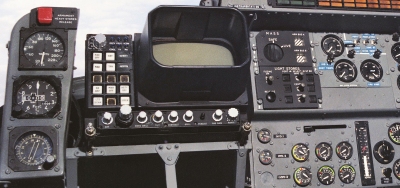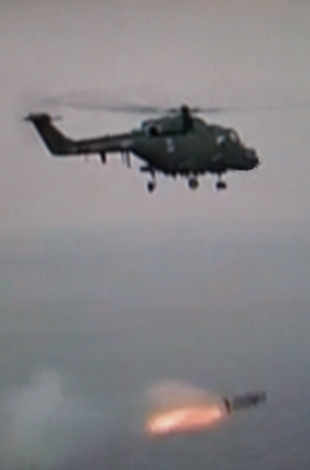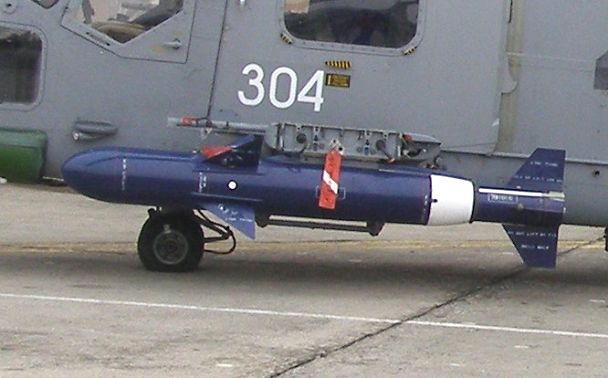Seaspray Mk 1 Radar
 |
On 14th December 2011 The
Helicopter Museum took delivery of an obsolete Seaspray Mk 1 surveillance
& tracking radar system, donated by SELEX Galileo, for fitting
into its recently restored Westland Navy Lynx HAS Mk.2 prototype.
This Lynx (XX910) was among several which carried out flight testing
of the early Seaspray radar installation, commencing in 1974, followed
by trials of the associated air-to-surface missile system, 'Sea
Skua' (CL-834). Missile-armed Fast Attack Craft (FACs), in service with the Soviet and Warsaw Pact navies, had emerged as a Cold War threat in the 1960s. The damage that these craft could inflict was demonstrated on 21st October 1967 when two Egyptian Navy 'Komar' class fast attack boats sank the Israeli destroyer 'Eilat', near Port Said, using their Soviet-designed SS-N-2 'Styx' ship-to-ship missiles. |
|||
| The contract to develop
Seaspray, which was designed specifically for the Westland Lynx
to counter the fast attack boat threat, had been awarded to Ferranti
Radar Systems, in Edinburgh, in July 1969. It specified a lightweight,
compact, high-performance, all-weather maritime radar that could
detect and track small, fast-moving, targets at significant distances
and provide illumination and guidance support for the 'Sea Skua'
air-to-surface missile being developed concurrently by the BAC Guided
Weapons Division, later BAe Dynamics and subsequently MBDA (UK)
Ltd. Ferranti Radar became, successively, GEC-Marconi, BAE Systems and SELEX Galileo. |
 |
|||
| Once the target had been identified it could be attacked using up to four helicopter-borne 'Sea Skua' missiles. The Seaspray Mk.1 radar, installed in a Westland Lynx HAS.2, was switched to tracking mode and one or more missiles would be launched, each dropping clear of the helicopter before ignition of the solid fuel booster and sustainer motors. Depending on the current sea state, the pilot would select from four available sea-skimming heights, to be maintained by radio altimeter, for his missiles. When nearing the target, now illuminated by the Lynx radar, the 'Sea Skuas' climbed to a height at which they could home in on the reflected energy, using their own semi-active radar homing heads. On impact each missile detonated a 24kg high-explosive, armour piercing warhead. | ||||
| The prototype Lynx HAS.2 in the Museum collection (XX910), carried out some of the early flight testing of the Ferranti Seaspray installation and the associated 'Sea Skua' air-to-surface missile system, which was getting underway in 1974. These trials were completed in early 1975 at RNAS Portland, Dorset, where the radar was assessed against fast patrol boats off the coast, despite interruptions by Russian surveillance trawlers trying to gather top secret electronic data. The first live firings of 'Sea Skua,' from a Lynx (XZ237) and from the ground, took place over Cardigan Bay, at the RAE Aberporth range, in November 1979. | ||||
| The British Government had provided development funding for 'Sea Skua' in 1975 and full production started in 1981. The first 30 production Lynx HAS.2s were ordered in 1973 and a further 30 were ordered in 1976. | ||||
 |
Following Argentina's invasion of the Falkland Islands, in 1982, Sea Skua was deployed to the South Atlantic before it had been declared fully operational. Eight missiles were fired from Lynx HAS.2 helicopters during the war, scoring eight hits. These resulted in two Argentine patrol boats being sunk and two damaged. From a total of 24 Royal Navy Lynx HAS.2s sent to the Falklands, the 16 already equipped to carry Seaspray radar and 'Sea Skua' missiles were re-allocated to those carriers, frigates and destroyers which were expected to reach the area of conflict first. |
|||
| The capabilities of the Lynx HAS.2s were augmented by addition of the Decca Tactical Air Navigation System (TANS) and of Racal 'Orange Crop' Electronic Support Measures (ESM), mounted on the nose, which detected radar and other emissions. These could often provide early target and launch data which reduced the duration of Seaspray activation. | ||||